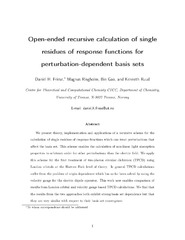Blar i forfatter "Friese, Daniel Henrik"
-
Benchmarking two-photon absorption cross sections: performance of CC2 and CAM-B3LYP
Beerepoot, Maarten T. P.; Friese, Daniel Henrik; List, Nanna Holmgaard; Kongsted, Jacob; Ruud, Kenneth (Journal article; Tidsskriftartikkel; Peer reviewed, 2015-06-25)We investigate the performance of CC2 and TDDFT/CAM-B3LYP for the calculation of two-photon absorption (TPA) strengths and cross sections and contrast our results to a recent coupled cluster equation-of-motion (EOM-EE-CCSD) benchmark study [K. D. Nanda and A. I. Krylov, J. Chem. Phys., 2015, 142, 064118]. In particular, we investigate whether CC2 TPA strengths are significantly overestimated compared ... -
Five-Photon Absorption and Selective Enhancement of Multiphoton Absorption Processes
Friese, Daniel Henrik; Bast, Radovan; Ruud, Kenneth (Journal article; Tidsskriftartikkel; Peer reviewed, 2015-05-12)We study one-, two-, three-, four- and five-photon absorption of three centrosymmetric molecules using density functional theory. These calculations are the first ab initio calculations of five-photon absorption. Even- and odd-order absorption processes show different trends in the absorption cross sections. The behaviour of all even-and odd-photon absorption properties shows a semi-quantitative ... -
The impact of interplay between electronic and steric effects on the synthesis and the linear and non-linear optical properties of diketopyrrolopyrrole bearing benzofuran moieties
Purc, Anna; Koszarna, Beata; Iachina, Irina; Friese, Daniel Henrik; Tasior, Mariusz; Sobczyk, Krzysztof; Pedzinski, Tomasz; Brewer, Jonathan; Gryko, Daniel T (Journal article; Tidsskriftartikkel; Peer reviewed, 2017-02-07)An in-depth investigation of the reaction of substituted salicylaldehydes with chloroacetonitrile led to the development of new conditions for the synthesis of 2-cyanobenzofurans. The crucial improvement lies in the use of phase-transfer catalysis in the second step, i.e., intramolecular aldol type condensation. In a two-step process, the reactants were transformed into a library of 3,6-bis(ben ... -
Intermolecular charge transfer enhances two-photon absorption in yellow fluorescent protein
Beerepoot, Maarten T. P.; Friese, Daniel Henrik; Ruud, Kenneth (Journal article; Tidsskriftartikkel; Peer reviewed, 2014)We present a quantum chemical study of the two-photon absorption (TPA) properties of yellow fluorescent protein (YFP), a mutant of the extensively studied green fluorescent protein. The aromatic chromophore of YFP has a π-stacking interaction with the aromatic ring of a tyrosine residue (Tyr203) in a parallel-displaced structure with a distance of about 3.4 Å. We study the TPA spectrum of the ... -
Note: Derivation of two-photon circular dichroism - Addendum to "two-photon circular dichroism" [J. Chem. Phys. 62, 1006 (1975)]
Friese, Daniel Henrik (Journal article; Tidsskriftartikkel; Peer reviewed, 2015-09-02)This addendum shows the detailed derivation of the fundamental equations for two-photon circular dichroism which are given in a very condensed form in the original publication [I. Tinoco, J. Chem. Phys. 62, 1006 (1975)]. In addition, some minor errors are corrected and some of the derivations in the original publication are commented. -
Open-ended recursive approach for the calculation of multiphoton absorption matrix elements
Friese, Daniel Henrik; Beerepoot, Maarten T. P.; Ringholm, Magnus; Ruud, Kenneth (Journal article; Tidsskriftartikkel; Peer reviewed, 2015-02-11)We present an implementation of single residues for response functions to arbitrary order using a recursive approach. Explicit expressions in terms of density-matrix-based response theory for the single residues of the linear, quadratic, cubic, and quartic response functions are also presented. These residues correspond to one-, two-, three- and four-photon transition matrix elements. The newly ... -
Open-Ended Recursive Calculation of Single Residues of Response Functions for Perturbation-Dependent Basis Sets
Friese, Daniel Henrik; Ringholm, Magnus; Gao, Bin; Ruud, Kenneth (Journal article; Tidsskriftartikkel; Peer reviewed, 2015-09-09)We present theory, implementation, and applications of a recursive scheme for the calculation of single residues of response functions that can treat perturbations that affect the basis set. This scheme enables the calculation of nonlinear light absorption properties to arbitrary order for other perturbations than an electric field. We apply this scheme for the first treatment of two-photon circular ... -
Origin-independent two-photon circular dichroism calculations in coupled cluster theory
Friese, Daniel Henrik; Hättig, Christof; Rizzo, Antonio (Journal article; Tidsskriftartikkel; Peer reviewed, 2016-05-03)We present the first origin-independent approach for the treatment of two-photon circular dichroism (TPCD) using coupled cluster methods. The approach is assessed concerning its behavior on the choice of the basis set and different coupled cluster methods. We also provide a comparison of results from CC2 with those from density functional theory using the CAM-B3LYP functional. Concerning the basis ... -
Rotational averaging of multiphoton absorption cross sections
Friese, Daniel Henrik; Beerepoot, Maarten T. P.; Ruud, Kenneth (Journal article; Tidsskriftartikkel; Peer reviewed, 2014) -
Solvatofluorochromic, non-centrosymmetric π-expanded diketopyrrolopyrrole
Grzybowski, Marek; Jeżewski, Artur; Deperasinska, Irena; Friese, Daniel Henrik; Banasiewicz, Marzena; Hugues, Vincent; Kozankiewicz, Bolesław; Blanchard-Desce, Mireille; Gryko, Daniel (Journal article; Tidsskriftartikkel; Peer reviewed, 2016-01-05)A novel non-centrosymmetric π-expanded diketopyrrolopyrrole was designed and synthesized. Strategic placement of tert-butyl groups at the periphery of a diketopyrrolopyrrole allowed us to selectively fuse one moiety via tandem Friedel–Crafts-dehydration reactions, resulting in a non-centrosymmetric dye. The structure of the dye was confirmed by X-ray crystallography, revealing that it contains a ...


 English
English norsk
norsk








